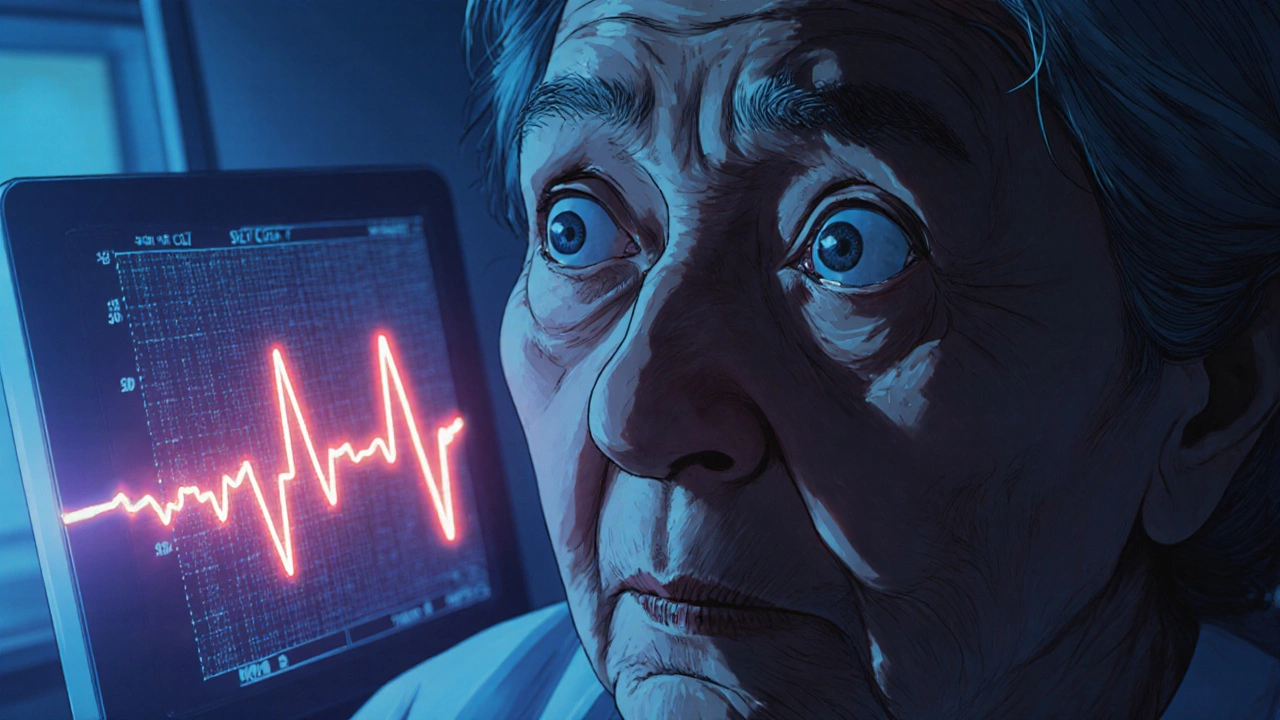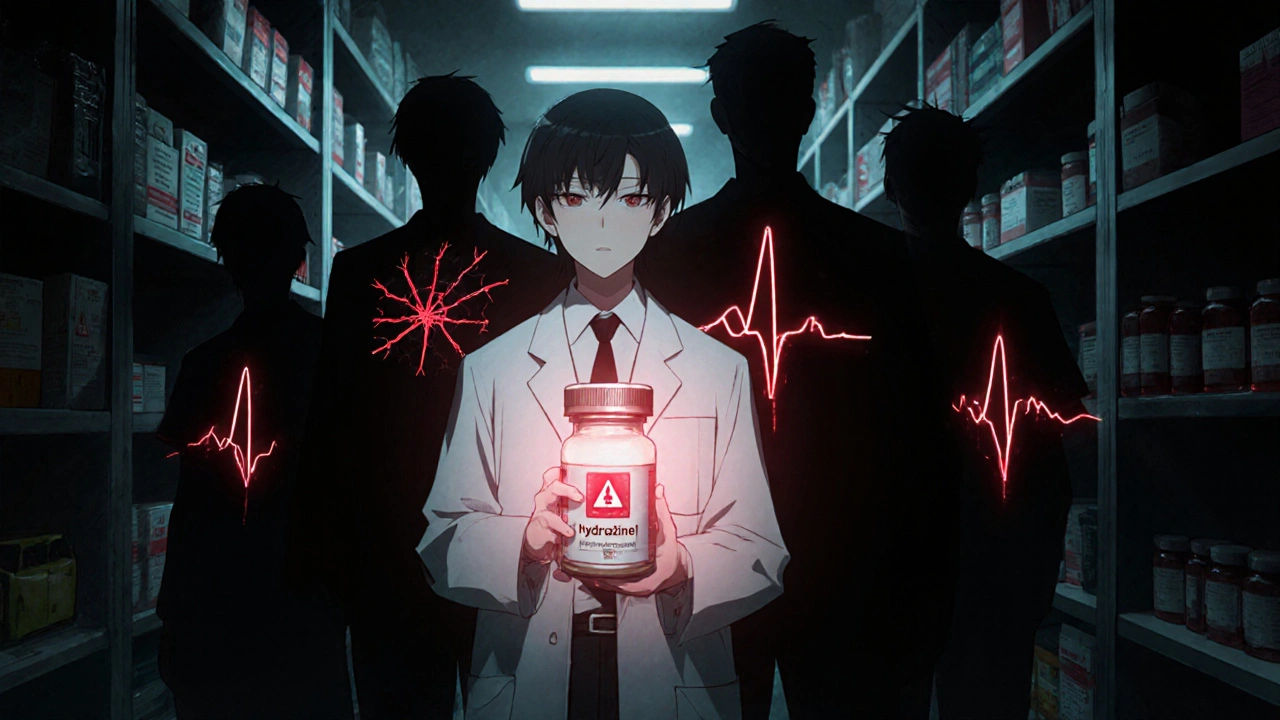
Hydroxyzine Cardiac Risk Assessment Tool
Risk Assessment
Hydroxyzine has been used for decades to treat anxiety, itching, and nausea. It’s cheap, effective, and widely prescribed - especially in older adults and people with chronic skin conditions. But here’s the problem: hydroxyzine can mess with your heart’s electrical system, and in rare but dangerous cases, it can trigger a life-threatening arrhythmia called Torsade de Pointes. This isn’t theoretical. It’s documented. And it’s happening more often than doctors realize.
How Hydroxyzine Affects the Heart
Hydroxyzine blocks a specific potassium channel in heart cells called hERG. This channel helps reset the heart’s rhythm after each beat. When it’s blocked, the heart takes longer to recharge between beats - this shows up on an ECG as a prolonged QT interval. A QT interval longer than 500 milliseconds is a red flag. At that point, the heart becomes electrically unstable. One extra beat, a sudden drop in potassium, or even a quick change in posture can trigger Torsade de Pointes - a twisting, chaotic rhythm that can lead to sudden cardiac arrest.
This isn’t just a lab finding. Between 1955 and 2016, over 59 cases of QT prolongation or Torsade de Pointes were directly linked to hydroxyzine use. Many of these patients had no prior heart problems. One 68-year-old woman developed Torsade just hours after taking 50 mg for anxiety. Another 45-year-old man, unaware he had inherited long QT syndrome, passed out 15 minutes after his first dose. These aren’t outliers. They’re warning signs.
Who’s at Risk?
Hydroxyzine isn’t dangerous for everyone. But it’s extremely risky for certain groups:
- People over 65 - their bodies clear the drug slower, leading to buildup
- Those with low potassium or magnesium - common in dieters, diabetics, and dialysis patients
- Patients on other QT-prolonging drugs - like certain antibiotics, antidepressants, or antiarrhythmics
- People with heart disease, bradycardia, or a history of fainting
- Those with genetic variants in CYP2D6 - poor metabolizers can’t break down hydroxyzine efficiently
Here’s the catch: many of these risk factors go unnoticed. A doctor might prescribe hydroxyzine for itchy skin without checking electrolytes. A nurse gives it to a dialysis patient for sleep - unaware that low magnesium and kidney failure double the risk. A pharmacist sees the order and doesn’t flag it because hydroxyzine is still labeled as a "safe" antihistamine.
What the Regulators Say
In 2015, the European Medicines Agency (EMA) reviewed all available data and made a hard call: hydroxyzine’s benefits don’t outweigh its risks unless used carefully. They cut the maximum daily dose from 300 mg to 100 mg for adults, and 50 mg for seniors. They added black box warnings. They told doctors to check ECGs before prescribing.
The FDA followed suit in 2019, adding hydroxyzine to its official list of drugs with known QT prolongation risk. The American Geriatrics Society now lists it as a "potentially inappropriate medication" for older adults. Yet, in 2022, U.S. doctors still wrote over 12 million hydroxyzine prescriptions - down from 18 million in 2014, but still too many.

How It Compares to Other Antihistamines
Not all antihistamines are created equal. Second-generation ones like cetirizine and loratadine barely affect the heart. Even diphenhydramine (Benadryl) - often used as a sleep aid - has less hERG blocking power than hydroxyzine.
Here’s the breakdown:
| Drug | QT Prolongation Risk | hERG Inhibition | Recommended for Elderly? |
|---|---|---|---|
| Hydroxyzine | Known Risk (CredibleMeds) | High | No - Avoid if possible |
| Diphenhydramine | Possible Risk | Moderate | Use with caution |
| Cetirizine | Minimal Risk | Very Low | Yes - Preferred |
| Loratadine | Minimal Risk | Very Low | Yes - Preferred |
| Fexofenadine | No Risk | Negligible | Yes - Safest option |
If you’re treating anxiety or itching in someone over 60, cetirizine or fexofenadine are safer bets. They work just as well for allergies. For pruritus, gabapentin or mirtazapine are now preferred in guidelines - and they don’t touch the heart.
What Doctors Should Do Before Prescribing
There’s a checklist now - and it’s non-negotiable:
- Check the patient’s QTc interval on a 12-lead ECG. If it’s above 450 ms (men) or 470 ms (women), don’t prescribe hydroxyzine.
- Review all medications using CredibleMeds. If they’re on any "Known Risk" drug, avoid hydroxyzine.
- Test potassium and magnesium levels. If either is low, correct it first.
- Use the lowest effective dose. For anxiety, 10-25 mg is often enough. For itching, 25 mg once or twice daily is standard.
- Never exceed 50 mg/day in patients over 65.
- Document your assessment. If you skip the ECG or ignore the risk factors, you’re not just being negligent - you’re putting someone’s life at risk.
Hospitals that implemented these rules saw a 78% drop in inappropriate hydroxyzine prescriptions. Electronic health records now block orders if the QTc is too long or if the patient is on conflicting meds. That’s progress.

What Patients Should Watch For
If you’re taking hydroxyzine, know the signs:
- Dizziness or lightheadedness - especially when standing up
- Palpitations - your heart feels like it’s skipping, fluttering, or racing
- Fainting or near-fainting episodes
- Unexplained fatigue or weakness
These symptoms can show up within 10 minutes or up to 20 days after starting the drug. Don’t wait. If you feel any of these, stop the medication and get an ECG. Don’t assume it’s "just anxiety" or "old age."
The Future of Hydroxyzine
Hydroxyzine isn’t going away. It’s still used in hospitals for procedural anxiety and in dermatology clinics for stubborn itching. But its role is shrinking. The 2025 European Society of Cardiology guidelines are expected to ban chronic use entirely - limiting it to single doses for short-term stress, like before surgery.
Researchers are already working on safer versions. A new compound called VH-01 is in early trials and shows 87% less hERG blocking than hydroxyzine - while keeping the same antihistamine effect. If it works, it could replace hydroxyzine in a decade.
For now, the message is clear: hydroxyzine isn’t a harmless sleep aid or a quick fix for itching. It’s a drug that demands respect. It needs an ECG. It needs a review of other meds. It needs awareness of electrolytes and age. Treat it like you would a blood thinner - because in some people, it’s just as dangerous.
The era of "it’s just an antihistamine" is over. We know better now. And we have to act on it.
Can hydroxyzine cause sudden cardiac arrest?
Yes - in rare cases, hydroxyzine can trigger Torsade de Pointes, a dangerous heart rhythm that can lead to sudden cardiac arrest. This risk is highest in people with existing heart conditions, low potassium or magnesium, or those taking other QT-prolonging drugs. While the overall risk is low, the consequences are severe, and cases have been documented in people with no prior heart history.
Is hydroxyzine safe for elderly patients?
No - hydroxyzine is listed as a potentially inappropriate medication for older adults by the American Geriatrics Society. Elderly patients metabolize the drug slower, increasing the risk of buildup and QT prolongation. If absolutely necessary, the dose should not exceed 50 mg per day, and an ECG must be checked first. Safer alternatives like cetirizine or gabapentin should be used instead.
How long does it take for hydroxyzine to affect the heart?
QT prolongation can occur as quickly as 10 minutes after taking hydroxyzine, or it may take up to 20 days. The timing depends on the individual’s metabolism, kidney and liver function, and whether they’re taking other medications. There’s no safe waiting period - risk exists from the first dose.
Should I get an ECG before taking hydroxyzine?
Yes - if you’re over 60, have a history of heart problems, take other medications, or have electrolyte imbalances, an ECG is essential before starting hydroxyzine. Even if you feel fine, a prolonged QT interval can be silent. Many hospitals now require an ECG before prescribing it. Don’t skip this step.
What are safer alternatives to hydroxyzine for anxiety or itching?
For anxiety, low-dose buspirone or SSRIs like sertraline are safer long-term options. For itching, cetirizine, fexofenadine, or gabapentin are preferred. Mirtazapine can help with both itching and sleep in elderly patients without cardiac risk. Always ask your doctor about alternatives - don’t assume hydroxyzine is the only choice.
Can I take hydroxyzine if I’m on a statin or antidepressant?
Many statins and antidepressants - including citalopram, escitalopram, fluoxetine, and clarithromycin - also prolong the QT interval. Taking them with hydroxyzine can multiply the risk. This combination is dangerous and should be avoided. Always check your medication list with a pharmacist or use the CredibleMeds database to screen for interactions.
If you’re currently taking hydroxyzine and have any of the risk factors mentioned - talk to your doctor. Don’t stop abruptly, but do ask for a cardiac safety review. Your heart doesn’t care how long you’ve been on the drug. It only cares whether it’s safe to keep going.
Write a comment
Your email address will not be published.






2 Comments
Been on hydroxyzine for years for eczema. Never knew it could mess with my heart. Got my ECG checked this week after reading this. QTc was 462. Doctor switched me to fexofenadine. No more itching issues. Glad I didn’t ignore this.
As a medical professional in Nigeria, I can confirm that hydroxyzine is often prescribed without any cardiac screening. Many patients are unaware of the risks. This post is a wake-up call for low-resource settings where ECGs are not routinely available. We need better guidelines and education.